Introduction
The charming, canal-filled city of Bruges often springs to mind when you think of Belgium. However, just an hour’s drive away lies Ghent, a vibrant city that seamlessly blends medieval history with a lively modern cultural scene. Discovering Ghent, Belgium’s overlooked medieval gem, offers a more authentic Belgian experience, making it a hidden treasure worth exploring.
Imagine wandering through cobblestone streets where the echoes of medieval merchants and the hum of contemporary cafés coexist harmoniously. With its stunning Gothic architecture and dynamic cultural offerings, Ghent provides a unique blend of old and new that captivates every visitor. Ghent is a treasure trove of historical and architectural marvels, from the grandeur of Saint Bavo’s Cathedral and the medieval Gravensteen Castle to the picturesque Graslei harbour and bustling markets.
Overlooked Gem
Ghent’s more touristy sibling, Bruges, often overshadows it. Yet this medieval marvel offers an equally enchanting, if not more authentic, Belgian experience. Unlike Bruges, which can sometimes feel like a museum frozen in time, Ghent is a city that pulses with life. It’s a city where history isn’t just preserved but lived in daily. Every visit is a journey through time and a vibrant urban culture. The city’s thriving culinary and dynamic arts scene adds to its multifaceted appeal.
Strategically located in the heart of Belgium, Ghent’s central position makes it an ideal destination for travellers seeking to explore the richness of Belgian culture without the crowds that flock to more well-known spots. Whether you’re drawn to its majestic cathedrals, lively markets, contemporary art installations, or the innovation in repurposing old industrial spaces, Ghent promises an enriching and immersive experience.
In this blog post, I’ll explore Ghent’s many facets—from its historical significance and architectural marvels to its cultural vibrancy and culinary delights. Join me as I uncover why Ghent is Belgium’s overlooked medieval gem.
Ghent’s Strategic Location
Nestled in the heart of Belgium, Ghent enjoys a strategic location. It is easily accessible from major cities such as Brussels and Antwerp. Situated at the confluence of the Scheldt and Leie rivers, Ghent has historically been a vital hub for trade and culture. Today, this central position continues to benefit travellers. Ghent offers convenient transportation links and is an ideal base for exploring the wider region.
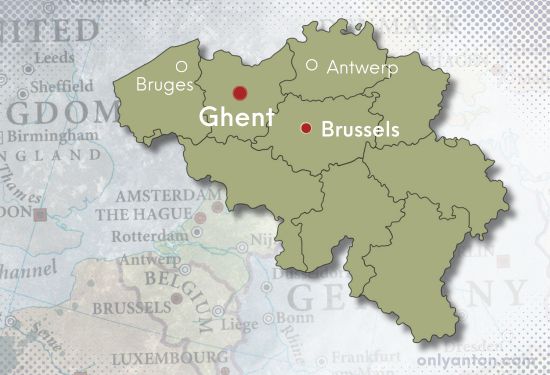
Ghent is just a 30-minute train ride from Brussels, Belgium’s capital, and about an hour from the international hub of Antwerp. This proximity to major cities ensures visitors can easily incorporate Ghent into their travel itineraries. The city’s well-connected public transport system, including regular train services and a comprehensive tram network, allows for effortless exploration within Ghent and neighbouring destinations. Whether you’re arriving by plane, train, or car, Ghent’s accessibility is one of its many appealing features. It’s a perfect stop for anyone looking to experience the beauty of Belgian culture.
Ghent’s Historical Backdrop
Ghent’s origins date back to the early Middle Ages. Its name is derived from the Celtic word ganda, meaning “confluence.” This name aptly describes its location at the meeting point of the Scheldt and Leie rivers. By the 11th century, Ghent had grown into one of Europe’s largest and most prosperous cities, rivalling even Paris and London in size and influence. The thriving wool industry fuelled the city’s growth and became the backbone of its economy during the Middle Ages.
The fertile lands surrounding Ghent, ideal for sheep farming, led to the city’s prominence in the wool trade. The city’s skilled artisans and weavers produced the high-quality woollen cloth in demand across Europe. This industry brought wealth and attracted merchants, artisans, and scholars. As a result, Ghent became an important centre of trade and culture. During the Flemish Golden Age in the 13th and 14th centuries, Ghent’s economic and cultural influence peaked. The city’s wealth financed the construction of stunning Gothic edifices. Many buildings, such as Saint Bavo’s Cathedral and the Belfry of Ghent, still stand today.
Treaty of Ghent
In addition to its economic prowess, Ghent played a crucial role in European political history. The Treaty of Ghent, signed in 1814, ended the War of 1812 between the United States and Great Britain. The negotiations occurred in the former Carthusian monastery, now known as the Gravensteen (the Castle of the Counts). This treaty was significant as it restored relations between the two nations and began a period of long-lasting peace and cooperation.
Throughout its history, Ghent has been a city of resilience and adaptability. From its medieval origins and prosperity during the Flemish Golden Age to its role in shaping European history, the city’s rich historical backdrop provides a fascinating context for visitors. Exploring Ghent is not just about witnessing its historical sites. It’s about understanding the pivotal role it has played in the broader European narrative.
Ghent’s Architectural Marvels
Ghent’s rich architectural landscape offers a fascinating journey through time. Its iconic structures reflect its historical grandeur and artistic evolution. The city’s most notable landmarks, such as Saint Bavo’s Cathedral, Gravensteen Castle, and the Belfry of Ghent, testify to its medieval heritage and architectural prowess.
Iconic Structures
Saint Bavo’s Cathedral: Saint Bavo’s Cathedral, a masterpiece of Gothic architecture, is perhaps Ghent’s most famous religious structure. It houses the renowned Ghent Altarpiece, also known as the Adoration of the Mystic Lamb, painted by Hubert and Jan van Eyck. The cathedral’s imposing façade and towering spire dominate the skyline, offering visitors a glimpse into the city’s spiritual and artistic heritage.
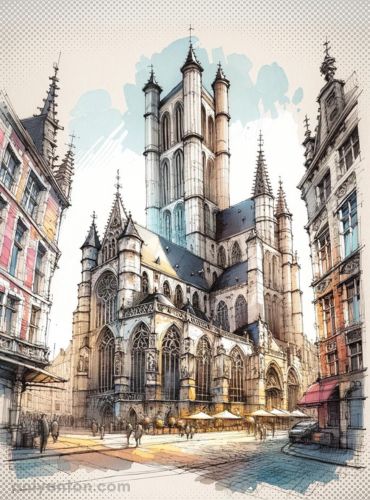
The interior is equally impressive, with intricate carvings, stained glass windows, and a rich collection of artworks and relics. Other notable works of art include Peter Paul Rubens‘s painting Saint Bavo Enters the Convent at Ghent and works by Lucas de Heere, Frans Pourbus the Elder, Caspar de Crayer, Antoon van de Heuvel, Lucas van Uden, and Jan van Cleef. The Treasury and Crypt house a valuable collection of liturgical artifacts and reliquaries, including the silver head of Saint John the Baptist.
Gravensteen Castle: Gravensteen, or the Castle of the Counts, is a medieval fortress that dates back to the 12th century. This imposing structure, built by Count Philip of Alsace, symbolized power and protection. Today, it offers a fascinating museum experience where visitors can explore the castle’s history, including its use as a court and prison. The castle’s turrets and stone walls evoke a sense of medieval life, making it a must-visit for history enthusiasts.
Belfry of Ghent: Standing tall as a UNESCO World Heritage site, the Belfry of Ghent symbolizes the city’s independence and prosperity. This 91-meter tower offers panoramic views of the city and houses a 54-bell carillon. The Belfry was constructed in the 14th century. It is part of a trio of medieval towers that includes Saint Bavo’s Cathedral and Saint Nicholas’ Church, creating a stunning architectural triptych.
Lesser-Known Architectural Gems
While Ghent’s iconic landmarks are well-documented, the city is also home to numerous lesser-known yet visually stunning buildings and hidden architectural gems.
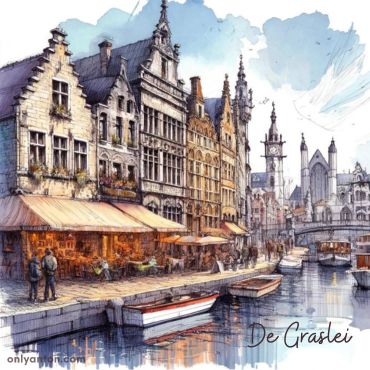
Old Graslei Harbour: The Graslei, with its rows of historic guild houses, is one of the most picturesque spots in Ghent. These buildings, dating back to the medieval period, showcase a variety of architectural styles, including Romanesque, Gothic, and Renaissance. The beautifully preserved façades that line the waterfront reflect the Graslei’s vibrant history as a thriving port.
Béguinages and the Cloth Hall: Ghent boasts three béguinages, serene enclaves that housed communities of religious women. These béguinages, recognized as UNESCO World Heritage sites, offer a peaceful retreat from the city’s hustle and bustle. Additionally, the Cloth Hall, located in the heart of the city, stands as a reminder of Ghent’s prosperous textile trade in the medieval era. Its grandeur and historical significance make it an essential stop for visitors.
Other Churches: Ghent is dotted with several other magnificent churches. St. Jacob’s Church, St. Nicholas’ Church, St. Michael’s Church, and St. Stefanus’ Church are all notable for their architectural beauty and historical importance. These churches, with their varied styles and rich histories, contribute to the city’s spiritual and cultural fabric.
Other Architectural Highlights
Louis Roelandt: The 19th-century architect Louis Roelandt played a significant role in shaping Ghent’s architectural landscape. His notable works include the university hall Aula, the opera house, and the main courthouse. Roelandt’s designs are characterized by their neoclassical style and grandiose scale, reflecting the city’s cultural and educational aspirations during his time.
Modern Architectural Highlights: Ghent’s architectural narrative continues into the modern era with innovative projects that blend contemporary design with historical contexts.
- Boekentoren (Book Tower): Designed by Henry Van de Velde, this university library building is a prime example of modernist architecture. Its sleek, functional design contrasts with the ornate historic buildings nearby, symbolizing Ghent’s commitment to education and innovation.
- Zebrastraat: This project unites living, economy, and culture within a renovated site. It showcases how old industrial areas can be transformed into vibrant community spaces.
- De Krook: The new central library and media centre, De Krook, is a striking piece of contemporary architecture. Its sleek lines and modern facilities make it a hub for knowledge and culture, embodying Ghent’s forward-thinking spirit.
From medieval fortresses to modern masterpieces, Ghent’s architectural marvels embody the city’s past and present. Each building tells a story, contributing to the rich mosaic that defines this overlooked medieval gem.
Ghent’s Cultural Tapestry
Ghent’s cultural scene is as vibrant and diverse as its architectural landscape. There are plenty of traditional festivals. In addition, local universities and institutions have fostered modern art installations and a dynamic arts community. This unique blend of old and new makes Ghent a cultural hub that appeals to residents and visitors.
Traditional Festivals
One of the most prominent events in Ghent’s cultural calendar is the Ghent Festival (Gentse Feesten), held every July. This ten-day celebration is one of the largest cultural festivals in Europe, transforming the city into a bustling carnival of music, theatre, dance, and street performances. The festival dates back to 1843 and reflects the city’s heritage while also embracing contemporary arts and entertainment. Performers fill the streets and squares. The festive atmosphere is contagious, drawing locals and tourists alike into the heart of Ghent’s cultural life.
The Festival of Flanders is another significant event that showcases Ghent’s commitment to the arts. This annual festival focuses on classical music, bringing together world-renowned musicians and orchestras for performances in various historic venues around the city. The festival highlights Ghent’s cultural sophistication and its dedication to preserving and promoting classical music traditions.
The International Film Festival of Ghent takes place every October and is a significant event in the city’s cultural calendar. Established in 1974, it has become one of Europe’s leading film festivals. It features a diverse program of films from around the world, with a particular emphasis on film music, culminating in the World Soundtrack Awards. This event underscores Ghent’s role as a significant player in the global film industry and its appreciation for the art of cinema.
Ghent hosts the Flanders Expo every five years. This large-scale event showcases Flemish culture, innovation, and industry. It reflects the city’s vibrant contemporary culture and its role as a hub of creativity and innovation.
Influence of Local Universities and Institutions
Its universities and educational institutions significantly influence Ghent’s vibrant arts scene. Ghent University, one of the leading universities in Belgium, plays a crucial role in fostering a lively cultural environment. The university’s various arts programs and initiatives encourage students to engage with the arts and contribute to the city’s dynamic cultural scene.
Moreover, institutions like the Royal Academy of Fine Arts and the School of Arts at University College Ghent provide platforms for emerging artists to showcase their work. These institutions cultivate local talent and attract international students and artists, further enriching Ghent’s cultural diversity.
These festivals, modern art installations, and educational institutions have woven the threads of tradition and innovation into Ghent’s cultural fabric. The blend of historical depth and contemporary vibrancy makes Ghent a unique cultural destination that promises a rewarding and immersive experience for all who visit.
Contemporary Ghent: Art and Innovation
Ghent is not just a city steeped in medieval history. It is also a thriving hub of contemporary art and innovation. The city’s vibrant art scene is a testament to its dynamic cultural life, with numerous galleries, street art installations, and innovative projects that breathe new life into old industrial spaces.
Contemporary Art Scene
Ghent’s contemporary art scene is rich and diverse, showcasing the work of both established and emerging artists. One of the key institutions is the S.M.A.K. (Stedelijk Museum voor Actuele Kunst), which houses a vast collection of modern and contemporary art. The museum is known for its cutting-edge exhibitions that often challenge traditional perceptions of art, making it a must-visit for art enthusiasts.
In addition to S.M.A.K., Kunsthal Gent is another significant venue that hosts a variety of contemporary art exhibitions and events. This cultural space is dedicated to experimental art and often collaborates with international artists, providing a platform for innovative and thought-provoking works. [https://kunsthal.gent/en/]
Street art also plays a significant role in Ghent’s artistic landscape. The city’s walls are adorned with vibrant murals and graffiti, turning public spaces into open-air galleries. Projects like Graffiti Street (Werregarenstraat) showcase the talents of local and international street artists, creating a constantly evolving collection of urban art.
Transformation of Industrial Areas
Ghent has successfully transformed several old industrial areas into creative spaces that foster innovation and community engagement. One notable example is the Bijloke site, a former hospital complex repurposed into a cultural hotspot. It now houses a variety of artistic institutions, including concert halls, theatres, and exhibition spaces, making it a central hub for cultural activities in the city.
Another innovative project is the Zebrastraat, which combines living, economy, and culture within a renovated site. This unique space offers residential units alongside art studios, galleries, and event spaces, promoting a vibrant community where creativity and daily life intersect.
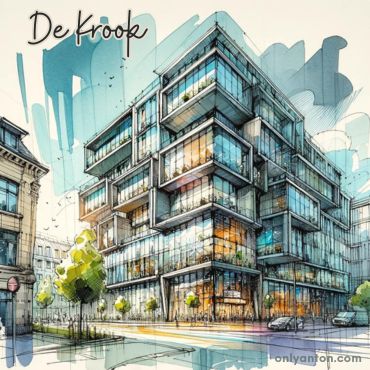
De Krook, Ghent’s new central library and media centre, is a striking example of contemporary architecture and innovation. Designed as a modern public space, it serves as a library and hosts various cultural and technological events. Its sleek, eco-friendly design reflects Ghent’s commitment to sustainability and modern urban living.
Balancing History with Modernity
Ghent balances its deep historical roots with a forward-thinking approach to urban development. The city’s commitment to sustainability is evident in its numerous eco-friendly initiatives, such as extensive cycling infrastructure and green public spaces. Ghent’s pedestrian-friendly city centre encourages walking and cycling, reducing the reliance on cars and contributing to a cleaner, healthier urban environment.
Innovative projects like Dok Noord, a redeveloped industrial site turned into a vibrant mixed-use area with shops, offices, and cultural spaces, exemplify Ghent’s ability to integrate modern living with historical preservation. These transformations preserve the architectural heritage of old industrial buildings and infuse them with new life and purpose, making them integral parts of the city’s contemporary landscape.
Ghent’s contemporary art and innovation scene combines creativity, history, and forward-thinking urban planning. The city’s ability to honour its past while embracing modernity makes it a continuously evolving destination that offers visitors a treasure trove of experiences. Whether you’re exploring cutting-edge galleries, admiring vibrant street art, or visiting repurposed industrial spaces, Ghent’s cultural and innovative spirit will surely inspire.
Culinary Delights of Ghent
Ghent’s culinary scene is a delightful fusion of traditional Flemish cuisine and contemporary gastronomic innovation. The city’s food culture reflects its history and disparate influences, offering a variety of must-try dishes and local specialties that will tantalize any food lover’s palate.
Traditional Ghent Cuisine
Waterzooi: One of Ghent’s signature dishes, Waterzooi is a creamy stew traditionally made with fish (though chicken versions are also popular). The dish features a rich broth of cream, egg yolks, and vegetables like leeks, carrots, and potatoes. This comforting meal perfectly embodies the region’s hearty, flavourful cooking style.
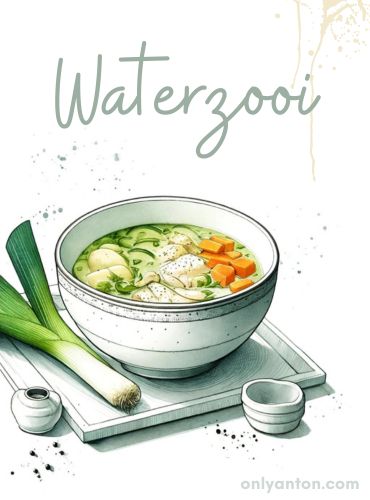
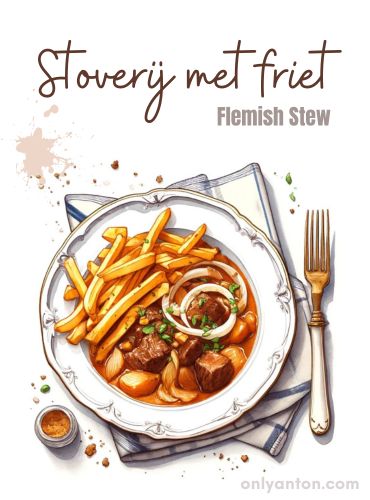
Stoverij: Stoverij, or Flemish beef stew (Stoofvlees), is another staple of Ghent’s cuisine. The dish consists of beef simmered in a dark beer broth and seasoned with mustard, onions, and spices. Fries or mashed potatoes typically accompany this dish. The use of local beer gives Stoverij its distinctive, robust flavour.
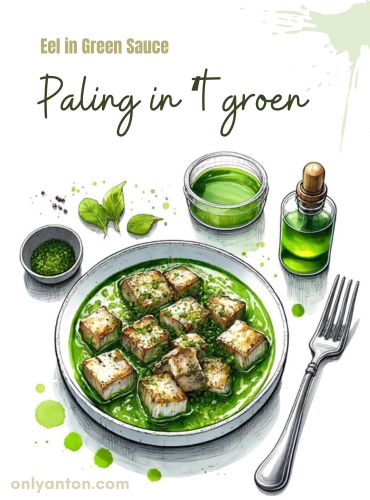
Paling in ’t Groen: This traditional dish features eel in a vibrant green herb sauce made from various fresh herbs, such as parsley, sorrel, and mint. Paling in ’t Groen is a testament to the region’s use of fresh, local ingredients to create unique and flavourful dishes.
Mastellen: Mastellen, often called “St. Hubert bread,” are tiny, round buns traditionally toasted with butter and sugar. These delightful treats are typically enjoyed during the St. Hubert feast but are available year-round in local bakeries.


Cuberdons: Cuberdons, also known as “neuzekes” or “little noses,” are cone-shaped candies with a soft, jelly-like interior. The raspberry-flavoured filling is a local delicacy that has become a symbol of Ghent’s confectionery tradition.
Tierenteyn Mustard: Tierenteyn mustard is a robust, spicy mustard made in Ghent. It is a popular accompaniment to many local dishes and is available in specialty shops throughout the city.
Recommended Eateries
Historic Taverns:
- Het Waterhuis aan de Bierkant: Located along the Leie River, this historic tavern is famous for its extensive beer selection and traditional Flemish dishes. It’s an ideal spot to enjoy a hearty meal with a picturesque waterfront view.
- De Graslei: Situated in one of Ghent’s most scenic areas, De Graslei offers a variety of local specialties in a charming, historic setting.
Contemporary Restaurants:
- Vrijmoed: For a modern twist on traditional Flemish cuisine, Vrijmoed offers innovative dishes that showcase the best local ingredients. The restaurant has earned two Michelin stars, making it a must-visit for food enthusiasts.
- De Graslei: Located in a historic building, this restaurant offers a unique dining experience by combining traditional Flemish dishes with a contemporary twist.
Thriving Brewery Scene
Ghent’s brewery scene is thriving, with numerous local breweries producing a variety of excellent beers. Here are some recommendations:
- Dulle Griet: This pub offers an extensive selection of over 500 beers, including many local brews. It’s a great place to sample some of Ghent’s finest beers. One of the most memorable experiences at Dulle Griet is trying the Max Van Het Huis beer. This house beer is served in a distinctive 1.2-litre boot-shaped glass. As part of the pub’s unique tradition, I had to leave one of my shoes as a deposit, which was then hoisted up in a basket above the bar. The atmosphere was lively and filled with both locals and tourists, all enjoying the wide variety of beers and the quirky, historical ambiance of the pub. The Max Van Het Huis beer itself was robust and flavourful, making the entire experience at Dulle Griet unforgettable.
- Gruut Brewery: Known for its unique brewing process that uses a mix of herbs instead of hops, Gruut Brewery offers a range of delicious beers that reflect the innovative spirit of Ghent’s brewing tradition.
Local Beers to Sample:
- Gruut Blonde: A refreshing beer with a unique herbal flavour, perfect for those looking to try something different.
- Gentse Strop: A classic Belgian blonde ale that is well-balanced and tasty, making it a great introduction to Ghent’s brewing culture.
- Buffalo Belgian Stout: A rich, dark beer with deep, complex flavours, ideal for beer enthusiasts looking to explore more robust brews.
Ghent’s culinary delights offer a sophisticated and diverse gastronomic experience that reflects the city’s historical roots and contemporary creativity. Whether you’re indulging in traditional dishes, exploring modern eateries, or sampling local beers, Ghent’s food scene promises to leave you with unforgettable culinary memories.
Exploring Ghent’s Neighborhoods
Ghent’s neighbourhoods each offer a distinct character and a wealth of attractions, making them ideal for exploration by foot or bike. Here’s a guide to some of the most captivating areas, complete with suggestions for walking routes, bike tours, and tips on where to shop, dine, and be entertained.
Patershol
Character and Attractions: Patershol is one of Ghent’s oldest and most picturesque neighbourhoods, characterized by its narrow, winding streets and charming medieval buildings. This area is known for its culinary scene, with a variety of excellent restaurants and cafes.
Walking Route: Start at the Gravensteen Castle and wander through the cobblestone streets, stopping by the House of Alijn, a museum that offers a glimpse into daily life in the past.
Dining:
- ’t Klaverblad: A cozy restaurant offering traditional Belgian dishes.
- Volta: A contemporary restaurant housed in a former power station known for its innovative cuisine.
Entertainment: Patershol is a great area to experience the local nightlife, with several bars and cafes offering a relaxed atmosphere.
Graslei and Korenlei
Character and Attractions: Graslei and Korenlei are two streets flanking the Leie River, known for their stunning medieval guild houses. This area is the heart of Ghent’s historic centre and offers beautiful views and photo opportunities.
Walking Route: Start at Saint Michael’s Bridge for panoramic views of the three towers of Ghent, then stroll along the Graslei and Korenlei, taking in the beautiful architecture and stopping at one of the riverside cafes.
Dining:
- De Graslei: A popular spot for enjoying local dishes with a river view.
- Pakhuis: A stylish brasserie in a former warehouse offering a mix of Belgian and international cuisine.
Shopping: The streets around Graslei and Korenlei are dotted with boutique shops selling everything from fashion to local crafts.
Saint Peter’s Abbey Neighborhood
Character and Attractions: This area is known for Saint Peter’s Abbey, a historical site with beautiful gardens and a museum. The neighbourhood has a more residential feel, with green spaces and cultural attractions.
Bike Tour: Rent a bike and start at Saint Peter’s Abbey, then cycle through the nearby Citadelpark, which houses the Museum of Fine Arts and S.M.A.K.
Dining:
- Saint Peter’s Abbey Café: Enjoy a relaxing meal or drink with a view of the abbey gardens.
- De Vooruit: A cultural centre with a popular cafe offering a range of dishes.
Entertainment: Check out De Vooruit for events such as concerts, theatre performances, and art exhibitions.
Ledeberg
Character and Attractions: Ledeberg is a vibrant and multicultural neighbourhood known for its markets and local flavour. It’s a great place to experience the everyday life of Ghent residents.
Walking Route: Explore Ledeberg Market, which offers a variety of fresh produce, local foods, and unique finds. Stroll through the streets to experience the lively atmosphere and diverse community.
Dining:
- Restaurant ’t Oud Clooster: Known for its Flemish cuisine and cozy ambiance.
- Karel De Stoute: A fine dining restaurant offering innovative Belgian dishes.
Shopping: Ledeberg’s markets and local shops offer a range of products, from fresh food to handmade goods.
Zuid
Character and Attractions: Zuid is a lively area with a mix of shopping centres, cultural venues, and modern architecture. It’s home to Ghent’s most prominent shopping street, Veldstraat.
Walking Route: Start at the Zuid Shopping Centre and make your way down Veldstraat, exploring the various shops and boutiques. Don’t miss the nearby Vooruit Arts Centre and the City Library (De Krook).
Dining:
- Balls & Glory: Known for its delicious stuffed meatballs and vegetarian options.
- Eat Love Pizza: A popular spot for gourmet pizzas made with fresh, local ingredients.
Entertainment: Zuid is an excellent area for catching a film or performance, with several cinemas and theatres nearby.
Practical Tips for Visitors
Planning a trip to Ghent involves a few practical considerations to ensure a smooth and enjoyable experience. Here are some essential tips on how to get around, the best times to visit, accommodation options, language considerations, currency tips, and other practical advice for navigating the city.
Getting Around Ghent
Public Transportation: Ghent has an efficient and well-connected public transport system operated by De Lijn, which includes trams, buses, and trains. Trams are particularly convenient for getting around the city centre. Major tram lines include Tram 1, which connects the main train station (Gent-Sint-Pieters) with the city centre, and Tram 4, which runs from Gent-Sint-Pieters to the northern suburbs.
- Tickets: You can buy tickets at vending machines, newsstands, or the De Lijn app. It’s often cheaper to purchase tickets in advance rather than on board.
- Day Passes: Consider getting a day pass if you plan to use public transport frequently.
Cycling: Ghent is a bike-friendly city with extensive cycling infrastructure, including dedicated bike lanes and bike-sharing programs. Renting a bike is a great way to explore the city at your own pace.
- Bike Rental: Several companies, such as Blue-bike and Donkey Republic, offer bike rentals. Many hotels also provide bikes for their guests.
- Bike Sharing: The city’s bike-sharing scheme, Velo, allows you to pick up and drop off bikes at various locations.
Walking: The compact city centre makes walking an easy and enjoyable way to see the sights. Most major attractions are within walking distance of each other, and the pedestrian-friendly streets enhance the experience.
Best Times to Visit
Spring (April to June): Spring is an excellent time to visit Ghent, with mild weather and blooming flowers. It’s perfect for exploring the city’s parks and outdoor attractions.
Summer (July to August): Summer is the peak tourist season, with warm weather and numerous festivals, including the Gentse Feesten in July. However, it can be crowded, so booking accommodation in advance is advisable.
Autumn (September to October): Autumn offers pleasant weather and fewer crowds, making it an excellent time for sightseeing and enjoying the city’s cultural events.
Winter (November to March): While winter is colder, Ghent’s festive atmosphere during the holiday season is enchanting. The Christmas market and winter festivities add a magical touch to the city.
Accommodation Options
Budget:
- Hostel Uppelink: Located in a historic building near the Graslei, this hostel offers affordable dormitory and private rooms.
- Ecohostel Andromeda: A sustainable option offering eco-friendly accommodation on a houseboat.
Mid-Range:
- Pillows Grand Boutique Hotel Reylof: This boutique hotel combines historic charm with modern amenities, offering comfortable rooms and a central location.
- NH Gent Belfort: This hotel is situated near the Belfry of Ghent and provides convenient access to major attractions and comfortable accommodations.
Luxury:
- Hotel Harmony: This luxury hotel is located in the Patershol district and features elegant rooms and stunning views of the city.
- 1898 The Post: Housed in a historic post office building, this luxury hotel offers unique, stylish rooms and a rooftop bar with panoramic views.
Language Considerations
Dutch is the official language of Ghent, but English is widely spoken, especially in tourist areas, hotels, and restaurants. French and German are also commonly understood. It’s always appreciated when you learn a few basic phrases in Dutch, such as “Dank u” (Thank you) and “Alstublieft” (Please).
Currency Tips
Belgium uses the Euro (€). Credit and debit cards are widely accepted, but it’s a good idea to carry some cash for small purchases or in case you visit places that don’t accept cards.
- ATMs: ATMs are widely available throughout the city, and you can withdraw Euros using international debit or credit cards.
- Tipping: Tipping is optional in Belgium, as the bill usually includes service charges. However, it’s customary to round up the bill or leave a small tip for good service.
Other Practical Advice
- Electrical Outlets: Belgium uses Type C and Type E electrical outlets. If you’re travelling from outside Europe, you may need a power adapter.
- Emergency Numbers: The number for police, fire, and medical emergencies throughout the European Union is 112. Within Belgium, you can call 100 for medical and fire emergencies and 101 for police emergencies. Emergency roadside phones are positioned every two kilometres on motorways in case of vehicular accidents.
- Safety: Ghent is generally a safe city, but as with any destination, it’s wise to stay aware of your surroundings and take standard precautions to protect your belongings.
By following these practical tips, you can ensure a smooth and enjoyable visit to Ghent, allowing you to fully appreciate the city’s rich history, vibrant culture, and modern amenities.
Conclusion
Ghent is a multifaceted destination that offers an enriching blend of historical charm and modern vibrancy. Its captivating medieval architecture tells stories of a rich past. The city’s cultural tapestry is woven with vibrant festivals along with a thriving contemporary art scene showcasing traditional and avant-garde works.
Culinary enthusiasts will find Ghent’s gastronomic offerings irresistible, with traditional dishes, delectable local specialties, and a dynamic brewery scene. The innovative transformation of old industrial spaces into creative hubs reflects Ghent’s ability to balance its historical roots with a forward-thinking approach to urban living.
Exploring Ghent’s diverse neighbourhoods provides a comprehensive experience beyond mere sightseeing. The city’s strategic location, efficient public transport, and welcoming atmosphere make it an accessible and appealing destination for travellers.
Whether you are a history buff, an art lover, a foodie, or simply looking for a unique travel experience, Ghent promises to deliver a genuine and multifaceted adventure. Its blend of old and new, tradition and innovation, makes it a must-visit city on any Belgian itinerary. Consider Ghent for your next trip and discover this overlooked medieval gem’s rewarding, authentic experiences.
We invite you to share your experiences if you’ve visited Ghent or to comment on what aspect of Ghent you find most intriguing. Stay tuned for upcoming posts about other hidden gems in Europe, and follow Only Anton for more travel inspiration.
Further Reading and Resources
For related posts on the Only Anton travel blog, see:
- Aachen Travel Guide: Explore Anton’s insights on visiting Aachen, another European hidden gem.
- Nijmegen’s Four Days Festival: Read about the unique experience of Nijmegen’s Four Days Festival.
To enrich your understanding of Ghent and help plan your visit, here are some additional resources that provide a wealth of information to help you make the most of your visit:
Official Resources
- Visit Ghent: The official tourism website with detailed information on attractions, events, accommodations, and more can be found here.
- Belgium Tourism: The national tourism board’s website provides comprehensive travel information, including city guides and cultural insights here.
- Visit Flanders: The website of the Tourist Office for Flanders provides plenty of information about the region, Flemish cities, and events. Visit the site here.
Travel Guides
- Lonely Planet: Ghent: Travel guides and tips from Lonely Planet, offering insights into the best attractions, dining, and accommodations. Find it here.
- Rick Steves Europe: Ghent: Travel advice and insights from Rick Steves, including itineraries and travel tips. Read the article here.
Cultural and Historical Insights
- Ghent University: For insights into the influence of local universities on Ghent’s cultural scene. Ghent University [https://www.ugent.be/en]
- S.M.A.K. (Stedelijk Museum voor Actuele Kunst): Learn more about Ghent’s contemporary art scene and upcoming exhibitions. S.M.A.K. [https://smak.be/en]
- Ghent Altarpiece: Explore detailed information about the famous Ghent Altarpiece in Saint Bavo’s Cathedral. Closer to Van Eyck [https://www.sintbaafskathedraal.be/en/history/the-ghent-altarpiece/]
Culinary Guides
- “The Best Restaurants in Ghent, Belgium,” by Chanun Poomsawai, The Culture Trip (May 2020): An article and recommendations on where to eat and what local specialties to try. Read it here.
- “Get a Taste of Goesting in Flanders,” VisitFlanders.com: Discover more about traditional Flemish cuisine and local specialties and “Goesting,” a unique desire or appetite for the good things in life.” Find the article here.
Additional Resources
- “36 Hours in Ghent,” by Seth Sherwood, New York Times (February 2019): A look at an often overlooked Flemish city. Read the article here.
- “Street Art in Ghent”: For those interested in the vibrant street art scene in Ghent, including a downloadable map of street art in the city, go to the VisitGent website here.




